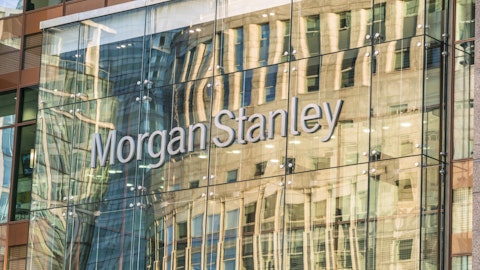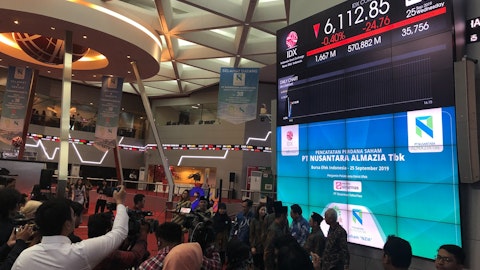Elliot Howard: Yes. Brody, this is Elliot Howard. I think on the SVB growth, we’re expected to be up slightly from about mid-50s range this year, and a lot of that in the Global Fund Banking. Craig mentioned that our pipeline was up $1.5 billion in the fourth quarter from where it was, just really as a result of kind of being back in the market more fully in the second quarter. I think we’re still seeing headwinds as Mark mentioned, second health care, just given the overall kind of environment. Longer term, I think we’re bullish on the SVB growth, market activity returns, just with a similar of a client in the outreach to new clients. I think with that, certainly, with the loan growth, we’d expect more deposit growth to come as well as that returns, and that’s a — keep a rate on what we have certainly again our savings product and direct banks. The more that we can grow the SVB, we do think that will be setting better for the overall bank in earnings.
Brody Preston : Got it. So just to confirm, though, for 2024, it does sound like we’re leaning more into the commercial bank and maybe kind of funding that with higher cost savings deposits. Is that fair?
Craig Nix: We’re also projecting mid-single-digit growth in the general bank as well. So it’s just pretty spread across the loan portfolios.
Operator: The next question today comes from the line of Christopher Marinac from Janney Montgomery Scott.
Christopher Marinac : Just wanted to ask more about the general criticized loan trends beyond what we saw in the DAC on office and the SVB portfolio?
Andy Giangrave: Yes. Sure. This is Andy Giangrave. Obviously, it’s — the trends we’re seeing are concentrated in general office and innovation. I think we have seen moderate migration in C&I, but nothing at this point of any concern.
Christopher Marinac : Great. And then the charge-off guide being a little higher now in Q1 and then a little lower for the whole year, does that indicate to sort of kind of past clean up or clean up from past issues? Or do you see sort of, I guess, some greater shoots that, that credit can improve as this year goes on?
Andy Giangrave: Yes. I think it’s going to be the continued theme that we spoke about last quarter and this quarter. It’s going to be concentrated in office innovation and our equipment finance. Obviously, there’s the secular shift in office that’s still a challenge, especially in this interest rate environment. The innovation, I think Mark highlighted well the challenges in the market. And then in the equipment finance side, it’s really working through some of those older vintages, but we feel like the tightening of our underwriting in that portfolio and some of the increase in collection efforts should start to show some benefits in the back half of the year.
Operator: Our next question today comes from the line of Brian Foran from Autonomous.
Brian Foran : Maybe to follow up on credit and these 4 kind of main portfolios, the Class C office, the 2 investor-dependent and in the small ticket equipment finance. I think they total about $6.5 billion now, and you give us the reserves on most. But then I guess you also have pretty heavy charge-offs already and some purchase accounting marks. I don’t know if it’s easier to talk about them as a group or some of them separate. Is there any way to like frame between the allowance, the charge-offs to date and the purchase accounting. Like what is the cumulative loss you’ve now recognized on these portfolios.
Craig Nix: Brian, this is Craig. I’ll take those individually and in aggregate because I think it’s important to really size that portfolio relative to the overall loan portfolio. If you take those 3 components, commercial, general office, equipment finance and the investor-dependent loans, whether the growth stages or early stage. Those totaled about $11.3 billion which is 8% of the loan portfolio. If you look at — and now — and so all those portfolios, we have total loss absorbing capacity of around 6.06% on net charge-offs for the year of around [$3.6 billion]. So if you aggregate those portfolios, our coverage is 1.9x, if we slice it down to the individual portfolios, commercial, general office, we have a coverage ratio of 1.1 and allow us 7.99% on charge-off price of $7.48.
On the equipment finance, the allowance is 3.52% and charge-offs 1.87% to around 1.9% coverage. And then on investor dependent, we have an allowance of 5.21 and a purchase discount of 3.58 which totals the total loss of building capacity of 8.79. So the allowance covers the charge-offs of 4.66, but when including that purchase discount, which is available to absorb losses takes it to 1.9x. So we feel really good about both our projections there and about our coverage in terms of charge-offs both that we’ve incurred and that we expect to occur moving forward.
Brian Foran : That’s really helpful. I guess on the buyback, I’m assuming you’re not going to answer the obvious question of sizing it for the second half of the year. But maybe can you just remind us, as we’ve moved through this year, there’s been CET1. There’s been CET1 ex the loss share. There’s been the leverage. It seems like some of the divergent metrics are starting to converge. But when you look at kind of your excess capital position and what number are you focused on? Is it the roughly 12 pro forma CET1 versus the 9% to 10% target? With the different capital metrics, what’s the focus right now as you move to midyear?





